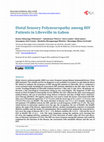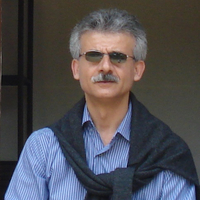Papers by ADOUKONOU Thierry
Revue Neurologique, 2017
r e v u e n e u r o l o g i q u e 1 7 3 S ( 2 0 1 7 ) S189-S193 Déclaration de liens d'intérêts L... more r e v u e n e u r o l o g i q u e 1 7 3 S ( 2 0 1 7 ) S189-S193 Déclaration de liens d'intérêts L'auteur n'a pas précisé ses éventuels liens d'intérêts.

Journal of Neurosciences in Rural Practice, 2020
Objective The main purpose of this article is to define prognosis of pregnancies in epileptic wom... more Objective The main purpose of this article is to define prognosis of pregnancies in epileptic women in Benin. Methods This was a case–control study that included 54 epileptic women who had at least one pregnancy matched to 162 controls on age, pregnancy term, and monitoring center. Information about epilepsy, treatment, pregnancy, and childbirth were collected. A logistic regression with odds ratio (OR) calculation was used to study the association. Results During pregnancy 22.22% of epileptic women experienced an increase in seizure frequency. Epileptics had more frequent miscarriages (OR: 1.84 [1.01–3.51]), more incidents during pregnancy (OR: 4.03 [1.04–15.60]), and were more often hospitalized (OR: 3.35 [1.46–7.69]) than women without epilepsy. They, more often, had premature children before 37 weeks of amenorrhea (OR: 2.10 [1.12–3.91]) and gave birth to low-birth-weight children (OR = 2.17 [1.00–4.76]). Conclusion Occurrence of a pregnancy in an epileptic woman in Benin is at r...

Neuroscience and Medicine, 2015
Background: The distal sensory polyneuropathy (DSP) was more frequent among diabetics, although i... more Background: The distal sensory polyneuropathy (DSP) was more frequent among diabetics, although its determinant was not well known among diabetics in Benin. Objective: We aimed to assess the frequency of DSP and its determinants among diabetics at Parakou. Methods: It was a cross-sectional study carried out from 1 March to 31 August 2012 and included 336 diabetics followed at the diabetes unit of Parakou hospital. The diagnosis of DSP was based on DNS (Diabetic Neuropathy Score) criteria and other criteria. All data concerning the diabetes mellitus were recorded. We used Epi-Info and SPSS 16.0 software to perform analysis. Results: They were 187 females (56.0%) with the mean age of 54.9 ± 10.9 years. 298 patients fulfilled criteria for DSP; the overall prevalence of DSP was 88.7%. The main associated factors in multivariate analysis were treatment duration of diabetes more than 4 years: OR = 36.7 [4.0 -336.9]; the elevated glycaemia: OR = 3.1 [1.4 -7.1]; the activity with high income: OR = 0.2 [0.0 -0.8]; the ethnicity: nagots/fon: OR: 3.7 [1.4 -12.5]. Conclusion: Those results suggested the high frequency of DSP among diabetics at Parakou.

The Pan African Medical Journal, 2019
Introduction Les accidents vasculaires cérébraux (AVC) constituent une des principales causes acq... more Introduction Les accidents vasculaires cérébraux (AVC) constituent une des principales causes acquises de l'épilepsie de l'adulte mais peu de données sont disponibles sur l'incidence de l'épilepsie après un AVC en Afrique. L'objectif de cette étude était d'estimer l'incidence de l'épilepsie chez les patients victimes d'AVC à Parakou. Méthodes Il s'est agi d'une étude de type cohorte dynamique ayant inclus 203 patients victimes d'AVC et hospitalisés dans le service de neurologie du CHU de Parakou. Les patients aux antécédents d'épilepsie étaient exclus du suivi. Les patients étaient suivis sur une période de 21mois allant du 1er Janvier 2013 au 30 Septembre 2014. L'épilepsie était définie selon les critères de la Ligue Internationale contre l'Epilepsie. Résultats Ils étaient âgés de 18 à 99 ans avec une moyenne de 58,4 ans ± 14,2 ans. Le délai moyen de consultation après l'installation des symptômes était de 54,3h (+/-11...

Universal Journal of Public Health, 2020
Toward the end of that scaling up of performance-based financing (PBF) started in Benin since 201... more Toward the end of that scaling up of performance-based financing (PBF) started in Benin since 2015, it's important to realize whether the impacts in terms of performance improvement of health facilities (HFs) will still be confirmed or not, especially as far as family planning (FP) is concerned. A longitudinal retrospective study covered by the period of 14 quarters of a year (Q1 2014 to Q2 2017), was conducted including all public and private functional HFs of the two health district. The outcome variable (performance of HFs in FP) was the increase rates of new acceptance for any modern contraceptive method through the study period. The independent variables were the quality of the structure, the quality of the process and the context. A linear regression model was adjusted to find out the explanatory variable of the performance; the significance threshold was 5%. 55 HFs participated to the study. There was no improvement in supplying process of FP services (p=0.308). There was no improvement in both trained staff (p=0.67) and midwifery staff (p=0.75); however, there was a significant improvement in the rest of the structure at the risk of 10% (p=0.063) and the performance in FP (p<0.001). In multivariate analysis, the evolution of the structure was the only explanatory variable (p=0.029) of HFs performance in FP; in rural areas, the structure-process interaction (p=0.038) was the explanatory variable of HFs performance in FP, whereas in suburban and urban areas, the models were not significant. PBF should act not only on the structures but also on the processes of supplying services, taking into account the context.

Neuroscience and Medicine, 2019
Objective: To study the frequency of neurological disorders associated to HIV infection. Methods:... more Objective: To study the frequency of neurological disorders associated to HIV infection. Methods: This cross-sectional study was carried out from 16th June to 16th September 2014 and included all 289 HIV-outpatients admitted to the Parakou University hospital. All data were recorded, physical examination was performed and the medical sheet of each patient was assessed. The diagnosis of neurological disorder (central and peripheral) was based on clinical features, past medical history, biological test and CT-scan data after multidisciplinary staff. Epi-data and Epi-Info 6.04C were used to perform analysis. Results: They were 73 (25.3%) male with a mean age of 38.0 years +/-10.1 years. The mean duration of disease was 48.5 months +/-37.1 months. 150 (51.9%) of them were at Stage 3 of the disease. All patients (99.7%) were infected by HIV1, 188 (76.1%) had CD4 cells at the onset of the follow-up less than 350 cells/mm 3 and 260 (90.0%) were on ART. Among the 289 patients, 110 had at least one neurological disorder, the frequency of neurological disorders was 38.1%. The main neurological disorders were peripheral neuropathy (34.3%), isolated headache (5.2%), stroke (0.7%), cerebral toxoplasmosis (0.7%) and one case of dementia (0.7%). The main associated factors were the age of patient and exposure on neurotoxic drug, especially ART. Conclusion: The neurological disorders were more frequent among HIV patients with a high frequency of peripheral neuropathy probably due to ART.

Neuroscience & Medicine, 2015
Distal sensory polyneuropathy (DSP) was more frequent among Human Immunodeficiency Virus (HIV) pa... more Distal sensory polyneuropathy (DSP) was more frequent among Human Immunodeficiency Virus (HIV) patients. The reliable tool for its diagnosis is not available everywhere in sub-Saharan Africa. We aimed to estimate the frequency of DSP among HIV patients in Libreville. We've conducted a cross-sectional study including all consecutives HIV-patients admitted to the HIV clinic in the University Teaching Hospital of Libreville (Gabon) between 1 May and 31 July 2014. All patients underwent a full neurological examination doing by two neurologists. The diagnosis of DSP was based on Brief Peripheral Neuropathy Screen (BPNS). We also collected the data concerning past medical history, the use of neurotoxic drug, history of disease and data of High Active Antiretroviral Therapy (HAART). The logistic regression was used to study the factors associated with DSP. They were 620 patients aged from 17 to 74 years with the mean age of 42.1 years ± 11.0 years and 570 (91.9%) were on HAART. The mean duration of disease was 57.6 ± 42.5 months. Among the 620 patients 170 fulfilled criteria for DSP, and the overall frequency of DSP was 27.4%. The associated factors in univariate analysis were the age, the occupation, the use of HAART, the HAART option, the stage of the disease, opportunistic disease, alcohol consumption, exposure to isoniazid, diabetes mellitus and the modes of contamination. But in multivariate analysis the associated factors were the stage of disease OR 2.7 [1.2 -3.7], diabetes mellitus OR 2.4 [1.4 -5.8] and the use of D4T in HAART OR 1.9 [1.1 -4.9]. The main symptoms among the patients were burning feet (47.6%), the tingling (40.0%), numbness (27.6%), alteration of ankle reflex (87.6%) and alteration of vibration sensation (27.6%). The DSP was more frequent among HIV patients and could be explained by the duration of the disease, the association with metabolic disease and the use of D4T.

World Journal of Neuroscience, 2013
Background: In sub-Saharan Africa, stroke constitutes a public health issue. Few studies were con... more Background: In sub-Saharan Africa, stroke constitutes a public health issue. Few studies were conducted to assess the cost involved in its treatment. Objective: To determine the factors involved in direct cost of stroke in Cotonou-Benin. Method: It consists in a transversal and prospective research of economic type with analytical and descriptive aim. It was conducted from 20 th February 2011 to 30 th September 2011. The research dealt with 122 stroke patients. With regard to the economic approach, bottom-up was the data collection technique which was adopted. Cost was estimated not only based on the patient himself/herself but considering societal aspect. Cost estimation period was hospitalization period. Data analysis was conducted via software such as Epi info and SPSS. Results: Overall expenses in terms of direct cost varied from $144.9 to $9393.9; average expenses were $1030.1 ± $101.7. Patients aged 50 and above had higher stroke hospitalization cost ($1277.4) than those aged below 50 ($857.4) p = 0.001; male patients made more expenses than females (FCFA 1157.5 against $831.8) p = 0.01; direct cost of stroke was increased in proportion to neurological deficit (score NIHSS) p = 0.043. This cost was higher in cases of hemorrhagic stroke than ischemic stroke (FCFA $1375 against $1098) p = 0.002. Stroke direct cost was also increased in proportion to severance of disability level of patients. Stroke type (hemorrhagic) and RANKIN score were firmly correlated to stroke hospitalization cost. Conclusion: Stroke is very expensive for patients in Benin and they constitute a burden for both patients and their family. There is a great need to increase awareness regarding risk factor control in order to reduce the cost involved in treating this malady.

Pain Studies and Treatment, 2018
Objective: We aim to study the relationship between migraine and obesity at Titirou in Parakou in... more Objective: We aim to study the relationship between migraine and obesity at Titirou in Parakou in 2017. Method: It was a case-control study which included 66 migrainers according to International Headache Society (IHS) criteria 2013 (case) matched to 132 controls by age, sex and residence. Size and weight have been measured in each subject. Body mass index has been calculated. Migraine history and sociodemographic information have been collected from 1 st May to 31 st August 2017 and analyzed by using Epi Info 7 software. The association between migraine and obesity was estimated by odds ratio and their confidence interval. Results: There has been no difference among those suffering from migraine and controls according to sociodemographic characteritics. Obesity has significantly been associated with migraine with OR 4. 24 (1.93 -9.25). The weight more than 70 Kg has been associated with the migraine with OR: 2.02 (1.06 -3.90). The overweight and obesity have been associated with migraine OR with respectively 1.9 (1.1 -3.9) and 4.4 (2.0 -9.5). No difference has been found between migraine and the clinical characteristics of migraine (type, severity, intensity). Conclusion: Obesity has been associated with migraine and has to be taken into account in migraine management.











Uploads
Papers by ADOUKONOU Thierry